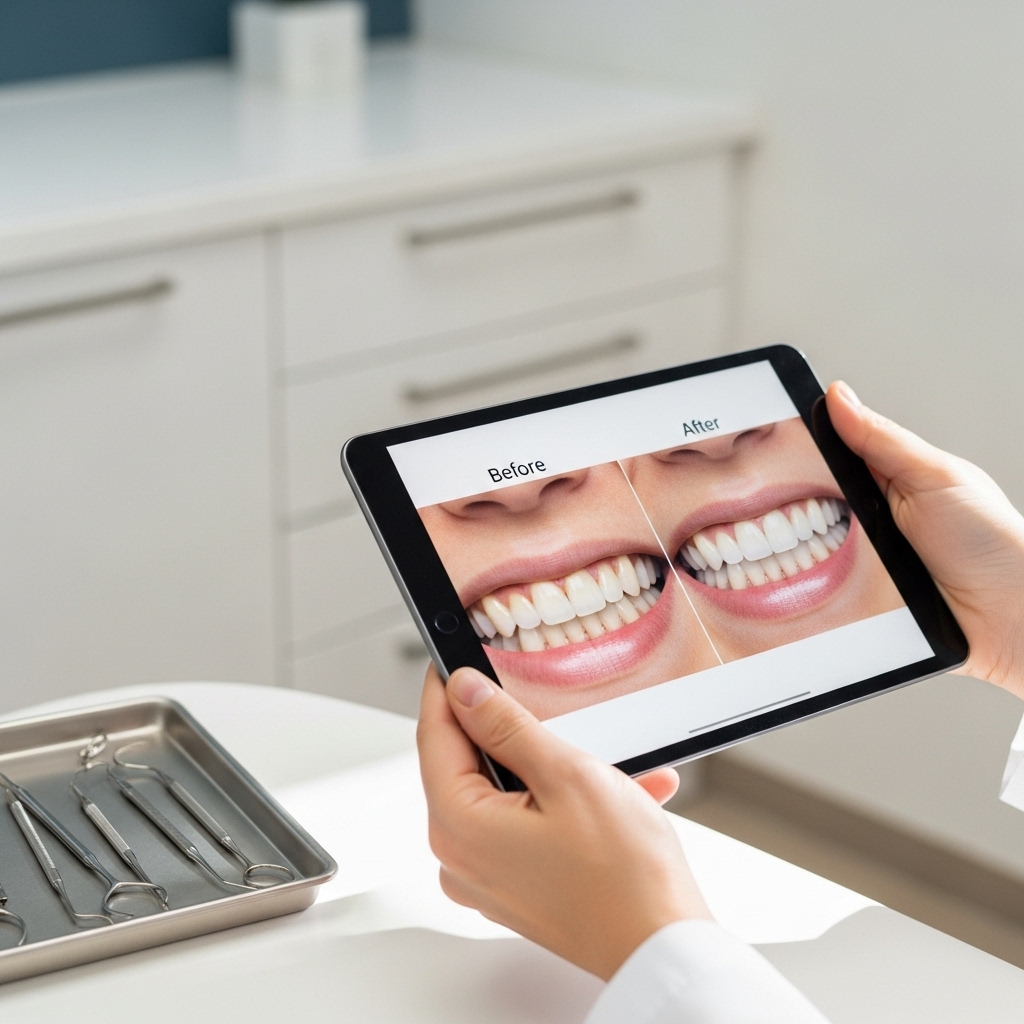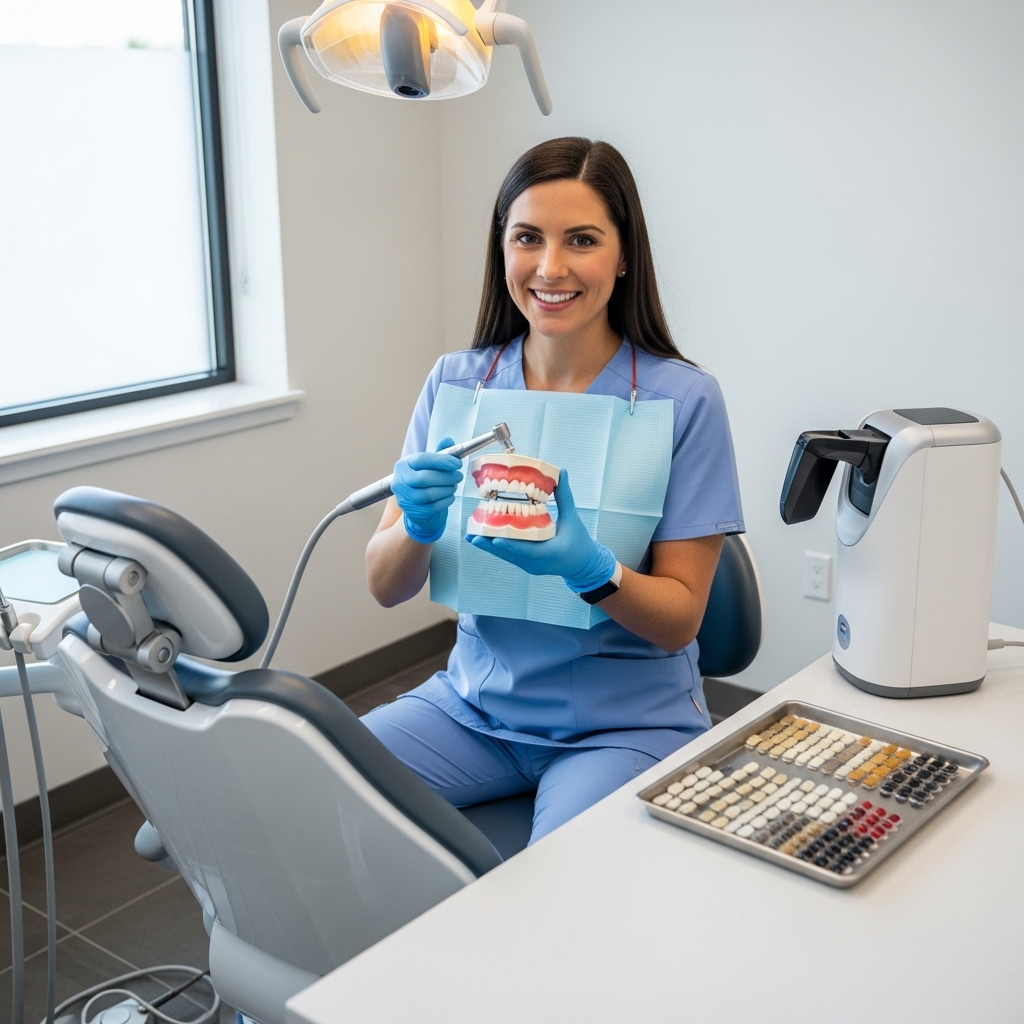There is a distinct moment in cosmetic dentistry that never gets old: the pause right before a patient sees their new smile in the mirror, and the quiet that turns into pure relief and joy. In Woodland Hills, where our days move from morning sunshine to evenings on Ventura Boulevard patios, those moments carry a special energy. People here favor results that look natural in bright light, feel comfortable when speaking, and stand up to candid photos with friends. Before-and-after images tell that story, but the real magic is in everything that happens between the “before” and the “after”—the planning, the previews, and the fine-tuning that make a smile feel like it has always belonged to you.
The best galleries show more than straight-on glamour shots. They reveal angles, close-ups, and smiles at rest and in motion. You should see surface texture, lifelike translucency at the edges, and gumlines that look healthy and balanced. You should also see variety—smiles that fit different faces, ages, and personalities—because the most successful cosmetic dentistry is never one-size-fits-all. In our community, that often means a bright, believable shade, gentle contours, and nuances that play beautifully with Woodland Hills sunlight.
Reading before-and-after photos like a pro
When you scroll through cases, look for consistency across the gallery rather than just one dramatic transformation. Do you see that the work blends with each person’s features? Are the gumlines calm and symmetrical? Is there a soft, natural sheen rather than a flat, overly glossy look? These clues tell you how carefully the plan was executed. Pay attention to the corners of the smile, too; they reveal whether width and arch form were considered so that the smile fills the face harmoniously.
Lighting matters. Natural or color-corrected lighting showcases the true character of ceramics and bonding. If results look beautiful under different conditions—indoors, outdoors, and with flash—the underlying craftsmanship is likely strong. You are not evaluating a single tooth; you are evaluating a system designed to work in daily life.
What happens between “before” and “after”
The journey starts with photographs and a conversation about what you want to change. Maybe it is staining that no longer responds to whitening, chipped edges from grinding, or spacing that has always bothered you. From there, the dentist develops a plan that balances aesthetics and function. Clear aligner therapy might be recommended to position teeth for conservative finishing. Whitening can set a baseline shade so restorations match perfectly. Provisionals let you test the proposed shape and length, ensuring your new smile feels comfortable when you speak, laugh, and relax your lips at rest.
These steps are not detours; they are how excellence is built. The provisional phase is especially influential. Many patients discover subtle preferences they could not articulate at the consult: a softer curve to the front teeth, a touch more width to support the lower lip, or slightly reduced brightness for an authentic look in direct sun. Capturing those insights before the final ceramics are crafted makes the “after” feel like it was meant for you.
Natural-looking veneers and bonding
Modern veneers and bonding have advanced to the point where expertly crafted work is virtually indistinguishable from natural enamel. Ceramics can be layered to create depth and translucency, while composite resins can be sculpted and polished to mirror microtexture. The most compelling before-and-afters show subtlety—no two smiles are identical, and each result respects the patient’s facial proportions, skin tone, and personality.
Look closely at edges and reflections. In a lifelike result, light glides across the tooth with a gentle gradient. The incisal edges often display a delicate halo, and the transition from tooth to gum looks seamless. These are the fingerprints of a clinician and ceramist working in harmony.
Function first: the invisible foundation
One of the biggest differences between a pretty picture and a genuinely successful “after” is function. When the bite is balanced, teeth protect each other from wear, and muscles relax. Patients frequently report that their smiles feel quieter—fewer chips, less tension, easier speech—after a makeover that corrected functional issues. Before-and-after galleries sometimes hint at this through improved arch form and more even contacts, but you will feel it most in daily life. If a practice talks about bite analysis alongside aesthetics, that is a strong indicator of lasting success.
Gum health also matters. Healthy, well-contoured tissue frames the work and contributes to a natural appearance. If you notice uniform, pink gumlines that gently hug each tooth in the “after,” it is a sign that the foundation was respected and prepared properly.
Local style in Woodland Hills smiles
Our community’s aesthetic tends toward bright, clean, and believable. Shade selection leans natural, and surface texture is designed to look authentic in abundant sunlight. That is why you will see veneers with subtle, hand-finished microtexture rather than a glassy, uniform surface. Reviewers often mention how comfortably their new smiles photograph outdoors, at brunch on Ventura or during golden-hour walks. This local sensibility informs everything from color to contour.
Personalization is at the heart of this style. A dentist might recommend a slightly warmer shade for someone with a golden skin tone, or a touch more translucency for a patient whose natural enamel has that characteristic. These adjustments are small on paper but significant in photos—and in how you feel when you smile.
Stories behind the transformations
Consider a Woodland Hills designer who had worn edges and subtle asymmetry that made her smile look tired. Aligners set the stage, followed by a few carefully designed veneers and selective bonding. In her “after,” the smile filled out, softened her expression, and looked luminous without calling attention to itself. Or the small-business owner who chipped a front tooth; precision bonding restored the edge so convincingly that his team could not tell which tooth was treated. These stories illustrate how thoughtful planning, not overcorrection, creates results that feel right at home.
Another patient, an avid hiker, wanted durability along with aesthetics. The plan addressed bite forces that had been chipping edges on weekend adventures, then refined shape and brightness. Months later, his review highlighted fewer chips and a renewed willingness to smile in photos on the trail. The “after” was as much about comfort as appearance.
How to evaluate authenticity up close
Zoom in on high-resolution photos if you can. Authentic results show gentle line angles, slight differences between lateral incisors and central incisors, and a natural transition at the gumline. Uniform, identical teeth can look artificial. Instead, seek character—delicate individuality that makes the smile yours. You should also see that the brightness suits the person’s complexion and that the teeth do not appear opaque in direct light.
Look for how the lips rest around the new shapes. Good design supports the soft tissues, creating a relaxed, confident expression. This is where provisional testing pays off; it ensures that the final contours complement your face in motion and at rest.
Maintaining your “after”
Great results deserve thoughtful care. Regular professional cleanings, mindful home hygiene, and a protective nightguard if you clench help maintain polish and prevent premature wear. Your dentist may recommend specific products to keep ceramics or bonding looking their best. Periodic check-ins also allow for minor refinements—polishing, reshaping, or refreshing bonding—so your smile continues to look and feel exactly how you want it to.
Lifestyle matters, too. If you enjoy coffee on the patio or red wine at dinner, simple habits like rinsing with water afterward can keep brightness consistent. None of this is complicated; it is about small, consistent actions that protect the craftsmanship built into your smile.
Frequently asked questions
What makes a before-and-after gallery trustworthy?
Consistency and detail. Look for multiple angles, close-ups, and a variety of case types. Results should show lifelike texture, natural gumlines, and personalization from one patient to the next. If the smiles all look the same, customization may be lacking.
How do I know if veneers will look natural on me?
Previews and provisionals are the key. Your dentist can show you proposed shapes digitally and then let you test-drive them in provisional form. This process lets you refine brightness, length, and contour until the look matches your preferences and facial features.
Can bonding deliver results comparable to veneers?
In the right cases, yes. For localized issues—chips, edges, small gaps—well-executed bonding can be remarkably natural. It is conservative and can be refined over time. For broader changes in shape, color, or alignment, veneers often provide greater durability and control.
Why do some “after” photos look unnatural?
Over-bright shades, overly uniform shapes, and flat surfaces can create an artificial appearance, especially in strong light. Skilled teams avoid these pitfalls by layering translucency, adding subtle microtexture, and customizing proportions to the face.
How long do results last?
With attentive care and a balanced bite, veneers, crowns, and high-quality bonding can serve beautifully for many years. Regular maintenance and sensible habits protect the appearance and function of your new smile.
Will my speech change after treatment?
Temporary adjustments are possible as your lips and tongue adapt to new contours, but provisionals allow the team to refine shapes for clear, comfortable speech before finalizing your restorations. Most patients report that any changes are brief and resolve quickly.
If you are ready to see how personalized planning turns inspiration into your own transformation, schedule a conversation with a trusted local expert. Meet with a respected cosmetic dentist in Woodland Hills to preview your potential, try shapes in provisional form, and move confidently toward results that feel as natural as they look—every day, in every kind of light.




